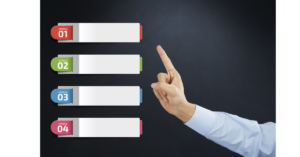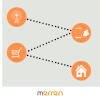Likert scale questions are an effective way to measure attitudes and opinions of your audience. These questions are a popular method used in surveys to measure personal preferences, opinions, and behaviors. In this blog, we will talk about the advantages of likert type questions and how to analyze likert data.
What are Likert scale questions?
Likert scale questions are a method of gathering opinions and attitudes through surveys. They include a statement and a range of response options, allowing respondents to indicate their level of agreement or disagreement. These scales provide valuable insights into people’s views on different topics.
For example this scale question might want to understand a user’s emotion towards a certain product. It could be as follows- ‘Please mark on the applicable point that represents your feelings- how do you feel about your recent purchase?’. For this question, there can be multiple questions with each denoting a range of emotions from positive to negative. It could be mapped in this manner- strongly disagree, disagree, undecided, agree and strongly agree.
Types of Likert scales
There are various types of Likert scales that you can make use of for your survey questions. These survey questions are widely used in survey research because they consist of a statement along with response options for the participants to choose from. Unipolar and bipolar are unique types of Likert scales that you can also consider using.
Unipolar Likert scale examples
Unipolar scales are a great way to gauge people’s opinions on a given statement. By asking respondents to rate their level of agreement or disagreement on a scale from 1 (strongly disagree) to 5 (strongly agree), you can gather accurate data on specific attitudes or opinions. For instance, in a customer satisfaction survey for an online store, you could use a five-point unipolar Likert scale question like “How satisfied were you with the speed of service?” This would provide valuable feedback for improving the customer experience.
Bipolar Likert scale examples
Bipolar Likert scales can measure people’s opinions on a given statement using polar opposites like “strongly agree” and “strongly disagree.” They are used widely in various industries such as market research, customer service, and survey research. For instance, this helps in measuring the effectiveness of pricing strategies or gauging customer feedback on online surveys. The best way to ensure accurate responses is by crafting clear and concise bipolar scale questions that avoid leading questions.
Advantages of using Likert scales
Psychologists like Rensis Likert discovered this easy way to gauge people’s opinions on various statements. Likert scales enable the measurement of attitudes by offering a structured approach with varied response options. This makes it easier to analyze and compare quantitative data. Be it a customer satisfaction metric or a market research survey, this method of getting feedback cannot be ignored.
Accurate results in surveys
To achieve accurate responses in your survey questions, it is important to write clear and concise statements that do not lead the respondent. Understanding the purpose of the survey and avoiding leading statements are also important to consider while framing scale points. While analyzing likert scale data, descriptive statistics should be used for quantitative data analysis.

Easy to administer
Likert scale questions are incredibly user-friendly and easy to administer. They provide a standardized format that is simple for respondents to understand, making it easier to collect large amounts of data in an organized manner. Since this method is widely used in various industries, there are many resources available to help you create effective and meaningful Likert scale questions that will help you gauge your customers’ thoughts and behaviors.
Write Effective Likert Scale Questions for Customer Feedback Surveys
When creating Likert scale questions, simplicity is key. It can easily get confusing and can bring skewed data. While collecting a range of responses , it is highly recommended to adopt a clear language that can be understood by all your respondents. Here are some tips that can help bring better response rates:
Understanding the purpose of the survey
To solicit authentic and valuable feedback from your audience, it’s essential to understand the purpose behind a likert type of question. Ensure that you maintain consistency in the number of response options throughout the survey to gauge people’s opinions accurately. Avoid asking double-barreled questions as they may result in inaccurate responses. Testing your Likert scale survey questions on a small group will help you assess their effectiveness.
Avoiding leading questions
To avoid leading questions in your questionnaires, keep the language simple and clear. Use balanced scales with an equal number of positive and negative response options. Avoid using double-barreled questions, and pilot test your survey with a sample group for clarity and effectiveness. By doing so, you will receive accurate responses providing valuable feedback on customer satisfaction surveys or market research data analysis.
Writing clear and concise questions
Just like any customer feedback survey questions, likert scale needs equal attention. Since it seeks responses from a range (agreeable/ not agreeable), the question has to be extremely specific, relevant and worded in simple language. Even when you use the multilingual feature, proofread each survey question and testify their comprehension level in advance.

Use Pre designed templates
When curating questions for this scale type can get tough, it is recommended to use templates. Templates have been tried and tested for future use. Templates eliminate the need to rethink the questions all over again. It can be customized for future use with slight adjustments as per the industry. The main essence of pre designed templates will be uniform across surveys.
How to analyze Likert scale data?
Here are some points to follow while analyzing responses from likert scale data.
Understanding the data type
When analyzing Likert scale data, calculate the mean score and standard deviation. Check for normal distribution, and compare responses across various groups. Statistical tests such as t-tests or ANOVA can be used to compare variables. Based on the results obtained through the analysis, you can gain valuable feedback on customer satisfaction, market research, or any other survey questions that were asked.
Descriptive statistics
To accurately analyze Likert scale questions in a survey, statistical analysis can help find significant differences and correlations between groups and variables. Data visualization through graphs or charts can make identifying patterns and trends easier.
Examples of Likert scale questions
Using scale questions in your survey is an easy way to gauge people’s opinions. For instance, “How strongly do you agree or disagree with the statement: ‘I trust this brand.’?” Using likert scale question examples such as this one can help you get the most accurate answers from your survey respondents.
Agreement
These survey questions ask respondents to gauge their level of agreement or disagreement with a given statement on a Likert type of a customer feedback survey. The likert scale responses can reveal valuable insights such as customer feedback and market research data that businesses can use to improve their products and services.
Satisfaction
To effectively measure customer satisfaction in surveys, using the ‘satisfaction metric’ is another way to get accurate responses. These types of questions use a series of statements and response options to gauge people’s satisfaction level on a product/ service. Customer service surveys can include the following examples- “On a scale from 1-5 rate the speed of service”. The 1 can be denoted as ‘highly unsatisfactory’ to 5 being ‘highly satisfied’.
Conclusion
Likert scale questions are an effective way to measure attitudes and opinions in your survey. They provide accurate and reliable results while being easy to administer. To make the most out of your customer feedback data, curate clear questions that avoid confusion.
If you want to remove the cognitive heavy lifting from the equation, you can try our AI survey builder here. This can help you create instant surveys to collect customer feedback across mediums of your choice. It is time to supercharge your customer feedback protocols with Merren. Sign up for our 14 day free trial here now.





